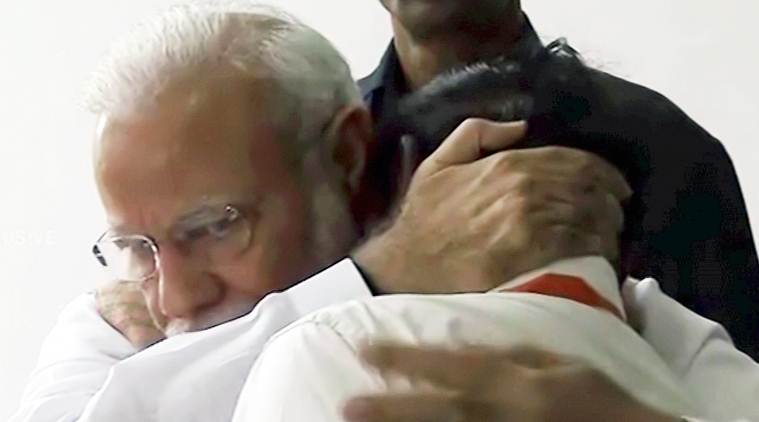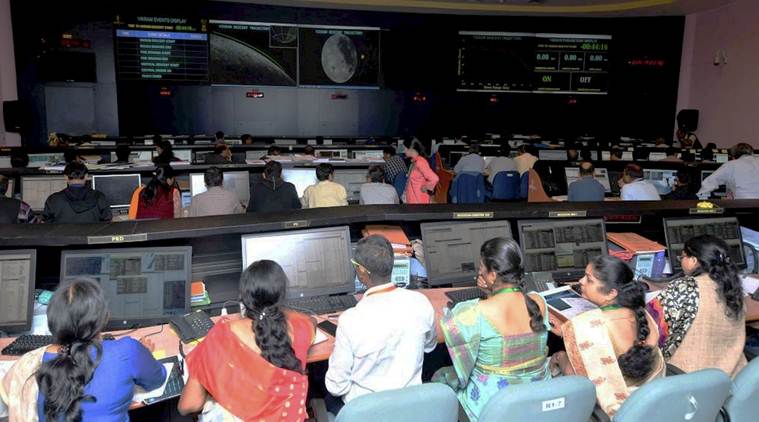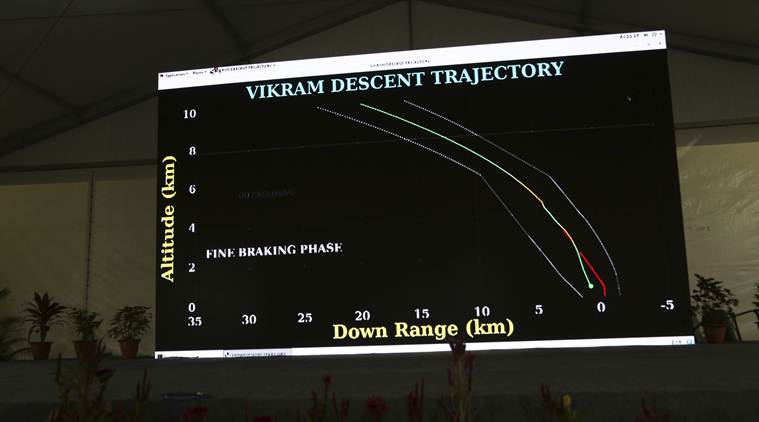
At 1.50 am on Saturday morning, more than 11 minutes after the Vikram lander of the Chandrayaan-2 mission began its final descent to the Moon, there was energetic applause from the scientists at the mission operations complex at the ground tracking centre in Bengaluru. The velocity of the lander had fallen below 200 metres per second, brought down from the initial 1,680 metres/sec, and an important small milestone had been crossed.
Vikram was on its way to land on the Moon as per plan. The bulk of the deceleration had already been achieved, and the next phase of the descent, during which the velocity was supposed to be brought down to about 2 metres/sec, was expected to be smoother.
Also Read | Chandrayaan 2: Vikram lander’s failure raises questions on manned mission
On a large screen, a green dot, representing the actual change in the velocity of Vikram, was moving exactly along the red line.
Final 5 mins and the heartbreak hours: Watching hope crash in mission control that represented the prescribed change in velocity for a safe landing.
Read | Chandrayaan-2: Meet the men and women behind India’s Mission Moon
Less than a minute later, the green dot appeared to break away from the red line. It moved inwards, indicating that the rate of change in actual velocity, or deceleration, was happening slower than what was prescribed. It meant that the lander was not slowing down at the required rate.

The green dot’s movement was noticed by everyone, but no one showed any signs of worry. Probably because, barely half a minute earlier, the dot had appeared to move away from the prescribed line, but had got back on track.
Read | An expert explains: 10, 9, 8… in the end, it was the 7 terrifying minutes
But this time was different. The green dot kept moving along an independent path for a few more seconds. About 15 seconds later, the first signs of worry appeared on the faces of some scientists, as an announcement was made that the signal from the lander was not being received. The announcement was not heard by people outside the control room, and probably not understood by anyone other than the scientists.
Instructions were exchanged among scientists to make efforts to re-establish contact with the lander. But with the passing seconds, the anxiety on the faces of some of the scientists gave the first indications that something was amiss. At 1.55 am, 17 minutes after the descent began, and about a minute and a half after the loss of signal, ISRO chairman K Sivan, sitting with a row of senior scientists in front of giant screens, pushed his chair back, got up, and walked towards his predecessor A S Kiran Kumar, who was standing a few feet away.

In the visitors’ gallery, veteran ISRO scientist B N Suresh, who was explaining some things to Prime Minister Narendra Modi, stopped and looked anxiously towards Sivan. Another veteran ISRO scientist, P S Goel, seated next to the Prime Minister, nervously got to his feet. The seniors could sense what was coming.
As Sivan and Kiran Kumar held discussions with other scientists, another announcement was made that signals from the lander were still not being received. At the time contact was lost, Vikram was just about 2 km above the moon’s surface. It was travelling at a speed of about 60 metres/sec, and dropping vertically at about 48 metres/sec. It was clear that if the velocity was not reduced immediately, the lander would meet the Moon’s surface at great speed within a few seconds.
But contact with the lander had been lost, and scientists had no way to ascertain whether Vikram had decelerated as it had been programmed to. Nor could they intervene from the ground station to control the speed, if the lander was not being able to do so on its own. They were helpless.
Also Read | ISRO hope: No news not necessarily bad news
At this point, the most optimistic hope was that the lander had actually completed its descent as planned, but its communication system had developed a problem, because of which contact had been lost. And the worst case scenario was that it had hit the Moon at an uncontrolled higher speed.
Even as Sivan and Kiran Kumar worked with the scientists trying to re-establish contact, the drooping shoulders and despairing faces told the story. Five minutes later, Sivan decided to finally break the news to the Prime Minister.
He listened intently and, after saying a few encouraging words to Sivan and his colleagues, left for his hotel. But within an hour, he sent a message that he would be back in the mission room at 8 am to meet the scientists and talk to them.
About 10 minutes after the PM left, Sivan decided to formally announce to the world what had happened.
“Vikram lander descent was as planned and normal performance was observed up to an altitude of 2.1 km. Subsequently, the communications from the lander to the ground station was lost. The data is being analysed,” he said in a choked voice.